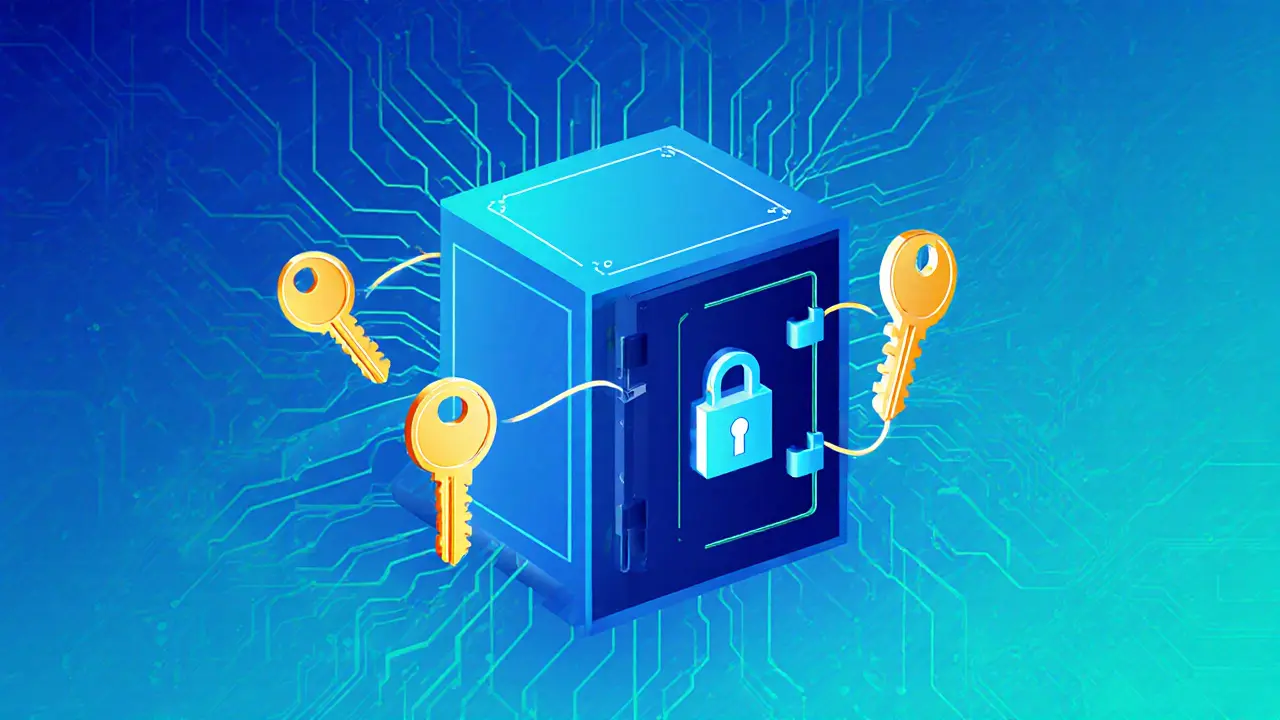Nov 9, 2025, Posted by: Ronan Caverly

MultiSig Wallet Security Calculator
Calculate how many signatures are needed (M) and total keys (N) to determine your wallet's security level.
Imagine losing all your crypto because one password got leaked. One mistake. One phishing email. One hacked device. That’s what happens with a single-signature wallet. Your whole balance hangs on one private key. If it’s stolen, gone. No second chances. MultiSig wallets change that. They don’t just make security better-they rebuild it from the ground up.
What Exactly Is a MultiSig Wallet?
A MultiSig wallet, short for multisignature wallet, needs more than one key to move money. It’s not one lock. It’s a set of locks, and you need several keys to open it. The system works on an "M-of-N" rule. For example, a 2-of-3 MultiSig wallet means you have three private keys total, but only two of them need to sign off for a transaction to go through. A 3-of-5 setup? Five keys exist, but you need three signatures. The math is simple: more keys required = harder to break in.This isn’t sci-fi. It’s how banks protect vaults. It’s how corporate accounts work. Now it’s available for crypto. The wallet itself doesn’t hold your coins-it’s a smart contract that tracks who can approve spending. When you try to send funds, the contract waits. It doesn’t act until the right number of signatures arrive. Until then, your money stays locked, safe.
Why Single-Signature Wallets Are Risky
Single-signature wallets are like leaving your house key under the mat. Convenient? Yes. Safe? No. If someone gets your private key-through a malware infection, a phishing scam, or even a careless backup-you lose everything. No alerts. No delay. No way back.There’s no backup plan. No oversight. No checks. Hackers don’t need to break into a system. They just need to trick one person. And that’s exactly what happens. In 2024 alone, over $2.3 billion in crypto was stolen through compromised private keys, according to blockchain security firm CipherTrace. Most of those thefts targeted single-key wallets. The pattern is clear: one key = one failure point.
MultiSig fixes this by design. Even if one key is stolen, the thief can’t move funds. They’d need two, three, or more keys-all held by different people or stored in different places. That’s a whole different level of difficulty.
How MultiSig Wallets Block Common Attacks
Let’s look at real threats-and how MultiSig stops them.- Phishing scams: You click a fake link, enter your seed phrase, and lose access. In a MultiSig setup, even if the attacker gets one key, they still need others. No deal.
- Hardware wallet theft: Someone steals your Ledger or Trezor. If it’s the only key? Done. But if it’s one of three in a 2-of-3 setup? The other two keys-stored offline or with a trusted friend-block the move.
- Insider threats: What if your business partner gets greedy? With a 3-of-5 wallet, they can’t act alone. They need two others to agree. Accountability kicks in.
- Loss of key: You misplace your USB drive with the private key. No problem. As long as you still have two of the other keys, you can recover. Redundancy saves you.
Trust Wallet and other modern platforms now include real-time Security Scanners that check transaction addresses against known scam contracts. Combine that with MultiSig, and you’ve got a system that doesn’t just react-it prevents.

Real-World Use Cases That Demand MultiSig
MultiSig isn’t just for tech heads. It’s used by businesses, DAOs, and families who can’t afford to lose money.- Businesses: A startup holding $500,000 in crypto uses a 2-of-3 wallet. One key with the CEO, one with the CFO, one with an external auditor. No one person can drain the account. Transactions need approval from two parties. That’s corporate governance built into crypto.
- DAOs: Decentralized organizations rely on MultiSig for treasury management. A proposal to spend funds goes out. Members vote. Only when enough signatures are collected does the money move. No central authority. No single point of control.
- Family inheritance: Parents set up a 2-of-3 wallet. One key with each parent, one with their adult child. If one parent passes away, the surviving parent and the child can still access funds. No probate delays. No locked assets.
- Escrow services: Buyers and sellers use MultiSig to hold funds until conditions are met. The seller delivers goods. The buyer confirms. Then, two out of three signatures (buyer, seller, neutral third party) release the payment. No trust needed-just code.
These aren’t hypotheticals. They’re happening right now. Companies like BitPay, Coinbase Custody, and Ledger use MultiSig for institutional clients. It’s not optional anymore-it’s standard for serious holdings.
Setting Up a MultiSig Wallet: What You Need
It’s not plug-and-play. But it’s not rocket science either. Here’s what you actually need to get started:- Hardware wallets: At least two. Store keys on separate devices-Ledger, Trezor, or similar. Never keep all keys on one machine.
- Wallet software: Not all wallets support MultiSig. Use trusted platforms like BitGo, Gnosis Safe, or the Lace Shared Wallet beta (which supports up to three co-signers).
- Secure backup: Write down each seed phrase on metal plates or fireproof paper. Store them in different locations-safe deposit box, home safe, trusted relative’s house.
- Clear rules: Decide your M-of-N setup before you create the wallet. 2-of-3 for personal use. 3-of-5 for teams. Document it. Share it with signers.
- Communication plan: How do you coordinate signatures? A group chat? A physical meeting? A secure app? Decide this upfront. Chaos kills security.
Don’t skip the backup step. Over 60% of crypto losses come from lost keys, not hacks. MultiSig protects you from theft-but only if you keep your keys safe.

Trade-Offs: Complexity vs. Safety
Yes, MultiSig is harder than a single-key wallet. You need to manage multiple devices. You need to coordinate with others. Transactions take longer. There’s a learning curve.But here’s the truth: security always costs something. You don’t leave your front door unlocked because you don’t want to fumble with the deadbolt. You install it because the risk of burglary is too high.
MultiSig wallets aren’t perfect. Poor setup can create new risks-like if all keys are stored on the same phone, or if one signer is untrustworthy. But these aren’t flaws in the technology. They’re human errors. Fix the process, and the system becomes nearly unbreakable.
Experts in blockchain security agree: any smart contract handling significant value should never rely on a single key. That’s not opinion-it’s protocol. The most secure wallets in the world use MultiSig. Bitcoin’s own core developers recommend it. Ethereum’s institutional custodians demand it.
Where MultiSig Is Headed
The future of crypto security is MultiSig. It’s already standard for institutions. Now, it’s moving to individuals.Wallet interfaces are getting better. You no longer need to manually sign raw transactions. Platforms now offer guided setup, visual approval flows, and automated alerts. Trust Wallet’s Security Scanner now rates transaction risk in real time-low, medium, high-and blocks high-risk moves before they happen. Combine that with MultiSig, and you’ve got a system that doesn’t just protect-it educates.
Expect to see MultiSig built into mainstream wallets within the next two years. Mobile apps will let you add co-signers with a tap. Family accounts will use it for shared savings. DAOs will use it for payroll. The goal isn’t to make crypto harder. It’s to make it safe enough for everyone.
If you hold more than a few thousand dollars in crypto, you’re already a target. Single-key wallets are a liability. MultiSig isn’t a luxury. It’s the baseline for responsible ownership.
Can I use MultiSig with my existing hardware wallet?
Yes, but only if your wallet software supports MultiSig. Ledger and Trezor hardware wallets can be used as part of a MultiSig setup, but you need compatible software like Gnosis Safe, BitGo, or Casa to manage the multisignature rules. The hardware wallets store your private keys securely, while the software handles the approval logic. You can’t just enable MultiSig through the device’s native app alone.
What happens if one of my co-signers disappears or dies?
It depends on your setup. In a 2-of-3 wallet, if one signer is gone, you still have two keys left-you can still access funds. But if you’re using a 3-of-3 setup and one person dies, you’re locked out unless you’ve planned for recovery. Always choose an M-of-N where M is less than N. For example, 2-of-3 or 3-of-5. That way, you build in redundancy. Also, document recovery steps and share them with a trusted person who isn’t a signer.
Is MultiSig slower than regular wallets?
Yes, but only during setup and approval. A regular wallet sends funds instantly with one click. A MultiSig wallet requires multiple approvals, which can take hours or days if signers aren’t available. But that delay is the whole point-it stops impulsive or malicious moves. For everyday small transactions, stick to a single-key wallet. For larger amounts or shared funds, the slowdown is a feature, not a bug.
Can I use MultiSig for staking?
Absolutely. In fact, MultiSig is ideal for staking. Many staking pools and validators now require MultiSig for treasury access. If your staking rewards are held in a single-key wallet, a breach could wipe out months of earnings. With MultiSig, even if one key is compromised, the staked assets remain protected. Some platforms, like Trust Wallet, now offer MultiSig staking with built-in security scanning to flag suspicious validator addresses.
Do I need to trust the people I add as co-signers?
You don’t need to trust them with your life-but you do need to trust them with access. MultiSig doesn’t eliminate the need for trust entirely. It reduces the damage if someone turns bad. If you add a co-signer who’s dishonest, they can’t steal everything alone. But they could block your access or force you into a bad transaction. Always choose co-signers carefully. Use people with technical understanding and proven reliability. Avoid adding family members who don’t understand crypto. They’re more likely to cause problems than prevent them.

Author
Ronan Caverly
I'm a blockchain analyst and market strategist bridging crypto and equities. I research protocols, decode tokenomics, and track exchange flows to spot risk and opportunity. I invest privately and advise fintech teams on go-to-market and compliance-aware growth. I also publish weekly insights to help retail and funds navigate digital asset cycles.